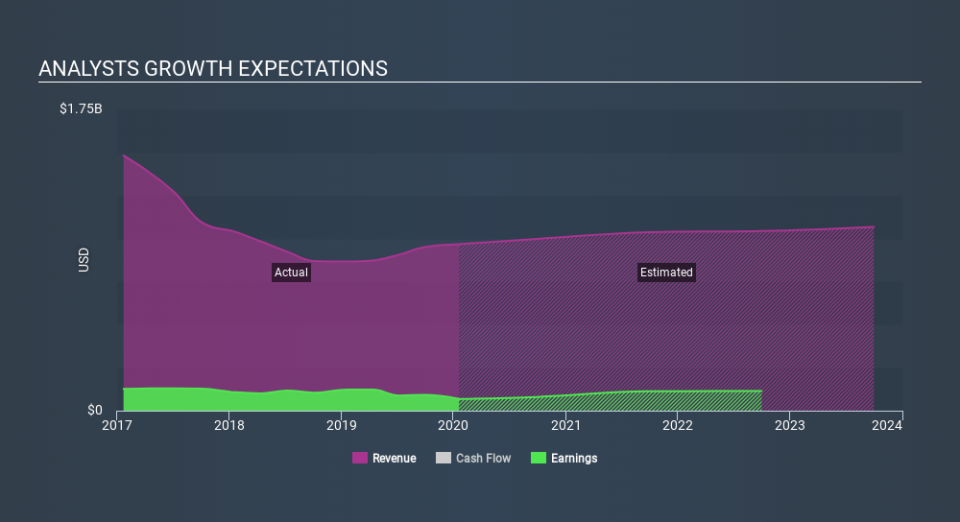Jack in the Box Inc. Earnings Missed Analyst Estimates: Here's What Analysts Are Forecasting Now

Jack in the Box Inc. (NASDAQ:JACK) last week reported its latest first-quarter results, which makes it a good time for investors to dive in and see if the business is performing in line with expectations. Sales of US$308m surpassed estimates by 3.8%, although statutory earnings per share missed badly, coming in 76% below expectations at US$0.33 per share. Earnings are an important time for investors, as they can track a company's performance, look at what top analysts are forecasting for next year, and see if there's been a change in sentiment towards the company. Readers will be glad to know we've aggregated the latest statutory forecasts to see whether analysts have changed their mind on Jack in the Box after the latest results.
View our latest analysis for Jack in the Box
Taking into account the latest results, the most recent consensus for Jack in the Box from 17 analysts is for revenues of US$997.7m in 2020, which is an okay 3.2% increase on its sales over the past 12 months. Statutory earnings per share are expected to leap 47% to US$3.98. Yet prior to the latest earnings, analysts had been forecasting revenues of US$972.8m and earnings per share (EPS) of US$4.55 in 2020. So it's pretty clear analysts have mixed opinions on Jack in the Box after the latest results; even though they upped their revenue numbers, it came at the cost of a real cut to per-share earnings expectations.
There's been no major changes to an analyst price target of US$94.47, suggesting that the impact of higher forecast sales and lower earnings won't result in a meaningful change to the business' valuation. There's another way to think about price targets though, and that's to look at the range of price targets put forward by analysts, because a wide range of estimates could suggest a diverse view on possible outcomes for the business. The most optimistic Jack in the Box analyst has a price target of US$105 per share, while the most pessimistic values it at US$72.00. Analysts definitely have varying views on the business, but the spread of estimates is not wide enough in our view to suggest that extreme outcomes could await Jack in the Box shareholders.
It can be useful to take a broader overview by seeing how analyst forecasts compare, both to the Jack in the Box's past performance and to peers in the same market. One thing stands out from these estimates, which is that analysts are forecasting Jack in the Box to grow faster in the future than it has in the past, with revenues expected to grow 3.2%. If achieved, this would be a much better result than the 14% annual decline over the past five years. Compare this against analyst estimates for the wider market, which suggest that (in aggregate) market revenues are expected to grow 8.2% next year. So although Jack in the Box's revenue growth is expected to improve, it is still expected to grow slower than the market.
The Bottom Line
The most important thing to take away is that analysts downgraded their earnings per share estimates, showing that there has been a clear decline in sentiment following these results. They also upgraded their revenue estimates for next year, even though sales are expected to grow slower than the wider market. There was no real change to the consensus price target, suggesting that the intrinsic value of the business has not undergone any major changes with the latest estimates.
Still, the long-term prospects of the business are much more relevant than next year's earnings. At Simply Wall St, we have a full range of analyst estimates for Jack in the Box going out to 2023, and you can see them free on our platform here..
You can also view our analysis of Jack in the Box's balance sheet, and whether we think Jack in the Box is carrying too much debt, for free on our platform here.
If you spot an error that warrants correction, please contact the editor at editorial-team@simplywallst.com. This article by Simply Wall St is general in nature. It does not constitute a recommendation to buy or sell any stock, and does not take account of your objectives, or your financial situation. Simply Wall St has no position in the stocks mentioned.
We aim to bring you long-term focused research analysis driven by fundamental data. Note that our analysis may not factor in the latest price-sensitive company announcements or qualitative material. Thank you for reading.

